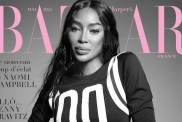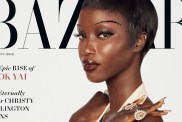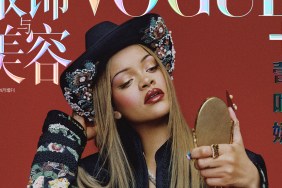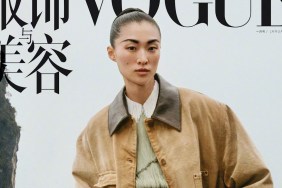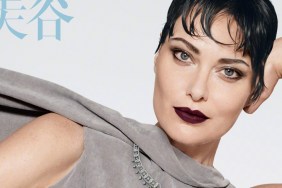Within the past six years, Koch has established herself as the only real milliner in mainland China and accumulated a slew of editorial credits from Chinese editions of top fashion glossies like Vogue, Harper’s Bazaar and Madame Figaro.
One of her pieces has just appeared on the cover of Vogue China’s 100th Issue Anniversary special, photographed by Mario Testino for December (pictured below). We spoke with Koch to find out more about how she became interested in millinery and took the plunge to pursue it full time.
theFashionSpot: Could you tell me a little bit about your background, where you’re from and how you became interested in making hats?
Elisabeth Koch: I was born in Atlanta, Georgia. I have Dutch parents, so I say I’m Dutch American. I left the United States when I was twelve and I’ve moved my entire life. At that point, I moved to Berlin, Luxembourg, London, Amsterdam and then Brussels and then Beijing. I was working in the financial sector for five-and-a-half years, Reuters, at ABN Amro, which is a big Dutch bank, at Fortis Investments, a big Belgian bank. Before I decided that I really needed to be doing something else, because in my free time after work, I would be knitting and drawing and sewing. And that, ever since I was born. So basically, it wasn’t a big shocker when I quit the banking world and, “Oh, I’m going to make hats.”
I also loved hats, I always collected vintage hats. When I finally documented them all, I had over 100 pieces that I got from my grandparents’ friends, from charity shops, through consignment stores. So I always loved hats and I always loved making things. It was only after having worked for five-and-a-half years that, “Well, I love making things and I love hats, let’s see if I can still make hats.” So I took a course in millinery in the UK and set the whole thing up here in China, of all places. I’d never been here before, by the way.
tFS: Why did you choose China?
EK: I was quite newly married, just one year, and my husband was a diplomat for the Dutch foreign service. And this was his — or, our — first posting. So I knew I was going to have to quit my job for the bank in Brussels anyway. And I was okay with that, but I just thought, this is my chance to really see if I can do what I want to do. And if not, I’ll … I was quite confident at the time. This was before the whole financial downturn. I was like, “Oh, I’ll just find another job in finance if this doesn’t work.” So I didn’t do any market research, I just came here and hit the ground running. Like, big time, hit the ground running.
tFS: I can’t imagine what it must be like to not only start a business but also to do it in a completely different culture, that must have been a really intense experience.
EK: I won’t lie, it was not easy. I started taking lessons, Chinese lessons, in Brussels, so my Chinese was minimal, so it was kind of… I can get around now, but I’m not fluent, it’s a difficult language. I’ve been here for six years now, by the way. But at the time, yeah. I had made a plan, and I was just like, stick to the plan, stick to the plan! It’s scary because, as a female… you know, I went to university, I did a Master’s degree, I had a good job. And then I quit it and I was like, oh my gosh: I have a mortgage, I quit my job, this is everything I’m not meant to do, I’m dependent on my husband. But only for the first few days. You arrive in this new country, you’re in a hotel, husband goes straight to work, and there I am thinking, what have I done? But it’s like, stick to the plan! Get your website going, find a website maker, logos business cards. I needed to get a SIM card! You know, I was going to live in China, at that point, all I knew was that I’d be here for three years, and I had to get this business going. So I really had to set it up that way, it wasn’t like a hobby gone wild. It really was, I want to make hats.
When I took the course in the UK I thought, I’m going to see if I like this, if I do, I’m going to buy everything — all the materials, which I did — put it in a container, shipped it all to China and when I got here, I had nothing really to show. Which was also really strange. I was meeting people, I would say, “I’m a hatmaker, I’m a milliner.” “Oh! Can I see pictures?” It’s like, “No…I don’t have anything!” I didn’t have a portfolio, I didn’t have my materials. Because we were just living in a hotel waiting for our container to arrive. It was scary.

tFS: Some places have strong hat cultures. Did people wear a lot of hats in Georgia?
EK: No, definitely people don’t wear hats in Georgia, so it wasn’t from there. But later, when I was older, as in going to university and there were weddings, I was in the UK, I did my Bachelor’s in the UK, so hats were a much bigger deal there. I was going to go to a wedding of a Lord and I was like, I need to have a nice hat for this wedding and as a student, hats in London were so expensive … and I’m so crafty anyway, I was like, I can put something together! So I took a stapler and nail polish and cardboard and feathers and a bunch of other things. And I made this amazing feather headpiece, which I wore. And that was the first hat I ever made without knowing I would ever make hats properly.
tFS: Do you also care about clothing?
EK: Of course! I’m not the person who’s on Style.com everyday. But I am definitely clued in and I get all the latest magazines. But I love vintage, it’s almost a problem. Estate sales when I’m in the U.S. or Goodwill…in China we don’t have second-hand clothes, everything’s new-new-new here. So that’s why I think it’s become even more special, because I have no access to it here. My grandmother is still alive, but she had a friend who was 99 and she died. And she had no children and she told me, “When I die, just come in and take whatever you want.” And this lady! I use her Dior handbag, I have so many Hermes shawls from her, Gucci. It was all from the Forties, Fifties, Sixties. And I love it. I wish I had her shoe size. Every time I wear her clothes, I’m like, “Thank you Lee!” Her stuff is living on, through me. And my sister works in fashion in New York, so I definitely am kept up to date through her, if not by myself.
tFS: So tell me a little bit about your business structure right now. And tell me how you got to a point — from sitting in the hotel room, your husband went to work, and you’re thinking, “I have to make business cards!” And then slowly but surely, you’ve gotten a website, created new work, one of your pieces was just on the cover of Vogue China. For people who aspire to do similar things…
EK: I think how it happened, in a bit of a nutshell… I don’t know how I got on some VIP party list, like invitation list — I think through my friends here. And there is … talk about economic downturn in the rest of the world, there is no sign of it here. This is in 2007/2008. There’s the opening of the new Armani store, or the new Anya Hindmarch shop or … there’s parties all the time. And once you’re on this list, you’re on this list. So I was going to parties of course dressed up head-to-toe in something, the most outrageous thing I could find. With a crazy hat! And this is pre-Lady Gaga! Well, it’s not that crazy, but I had like … a hat that was like a lobster crawling up the side of the head. And an Eiffel Tower on the head. And the Chinese like to take pictures anyway. If you’re wearing a hat, they’ll take pictures. If you’re wearing a crazy hat, it’s off the charts. I was wearing a motorcycle dress, with little pictures of motorcycles on it, it’s quite an old Italian one. And I made a hat to match it, with a little red motorcycle on it. And that was in 2008, it was in so many magazines, I didn’t even know … just by going to this party. And in these magazines, it has my name … you know Harper’s Bazaar … all of these magazines. People were saying, “Oh my gosh, who’s she? Who’s she?” Because you’re wearing a crazy hat. And when you’re in China, you pass out business cards like anything. And I gave them all my business cards and they gave me theirs and before I knew it, they were coming over all the time to pull hats for photoshoots. And within six months of being in China, I had twelve pages of Harper’s Bazaar. Of hats. I thought, “Oh my god, I made it! I made it! The phone is going to ring off the hook.” But six years later, I’m still here. The press I do have, I have to admit, it’s pretty crazy. It’s almost hard to keep up with the magazines. And I’ve even had a Vogue cover before, and Harper’s Bazaar covers. And Self, Good Housekeeping, Madame Figaro. But the special thing about this one is that it’s Mario Testino and it’s the 100th Anniversary Issue.

tFS: Have you found any peers in China?
EK: Before I came to China, I looked at many of the tools that I would need. And I saw it said, Made in China on the box. And I thought, Oh! I’ll get it there, I’ll get it there, I’ll get it there. And then I get here. Of course you can’t buy any of that stuff here, because it’s made in bulk and it’s shipped over to the west by container. And you cannot buy blocking pins, for example — pins that hold the felt on the wooden mold — those are made in China, but I can’t get them here, so I have to order them in the UK, for example. Or I order a lot of my materials in Holland. So when I came here, I found some English-language magazines, and I was looking for millinery materials — what I’m trying to say, I am in the only milliner in mainland China. I know that for a fact. There are hat factories, yes of course. There are hats that are designed, let’s say there’s a basic pattern — let’s say there’s a baseball cap or a men’s cap, a pattern that’s cut out and made in the factories. But the way I do it? By hand? No. And pulling the material by hand over a wooden mold? I’m the only one. There are some milliners in Hong Kong and Taiwan. But mainland China? No.
tFS: What is your relationship to the garment industry and the factories there? It does strike me as peculiar that you’re making these one-of-a-kind creations while China is this hub for mass production.
EK: First I thought it was awful that I couldn’t find a millinery supply store here. But then it’s such a blessing, because it’s forced me to look out of the box. And because of that, I’ve probably made hats I never would have, if I were in New York or London, or a place where I would have had access to millinery materials. And also, I’ll go to the local markets here and the textile markets, and I’ll see things and I’ll think, “I’m going to use that in a hat one day.” Or I’ll just buy stuff and it sits in my studio and one day, maybe even years later, I’ll use it and it’ll be perfect. It’s been a blessing in disguise because it’s made me go with materials I never would have used. I’ve used wood, I’ve used metals, I’ve used plastics. And a mix of the traditional and the new stuff.

tFS: What about sales? Clearly you’ve gotten a really strong response on the editorial side. Have you been able to sell a good amount?
EK: Of course, I definitely sell. And sales go up every year. But I would have expected more with the kind of press that I’m getting. Maybe because I’m quite a small business — it’s like, me and a shopkeeper. And I have some assistants. But with this kind of press, I’m really hoping that sales will increase. But sales are not bad! Not at all. I tailor my hats. I have a client that comes for a hat for Royal Ascot or the Melbourne Cup, which was just in November. And they’ll need a hat and I’ll make it, and that’s it. So I make one unique hat and there it goes. But I’ve just launched in October another label — it’s called the Blue Label — and it’s just my label but it’s blue, and those are limited-edition, so those are only part handmade, they’re not each unique pieces. There’s just more of each piece. I’m hoping, I’m trying at the moment to find buyers for those hats. To sell in bulk.
tFS: What’s the price point on pieces, approximately?
EK: It starts at about 2000 RMB, which is around $300. And it can go up to — this is the high-end label — and it can go to 5000 RMB and up, depending on what the client wants. And I work with Swarovski, I’ve been working with them for years. So obviously if a client wants it covered with Swarovski, the price can go up.
tFS: From what I’ve heard, China has a notoriously sexist business culture. I’ve heard that touches the fashion industry on the corporate side. But as you were saying, you quit your job, came to Beijing with your husband, had children and started your own business — did you encounter any resistance? Do you feel that your gender impacted the way you were received?
EK: No actually, I don’t. I’m thinking about that, now that you’re asking. I think in general, in Chinese companies, I think if you are Chinese, that may be the case. But I’m not Chinese, so I’m in a different place. It wouldn’t really apply to me, because I’m a foreigner. So I think they see me as a foreigner before a female. I know a lot of females here, Chinese as well, who have started businesses in fashion. Also I think that maybe if there is discrimination, there might be more in banking or law or something more corporate than the fashion world. Because all the editors-in-chief at the big magazines are women here — Chinese women. And people I work here are almost all women. And mostly, when I need to have a Chinese person translate for me, it’s almost always going to be a female over a man. The men hardly speak English. If anyone does, it’s the girls. It seems like the girls are more ambitious than the men here. Maybe exactly because of discrimination in the past.


